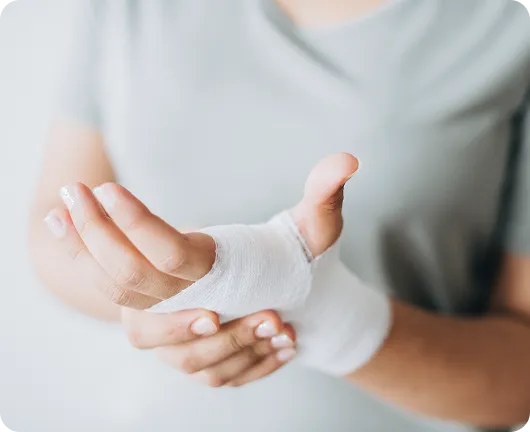Workplace Injury Treatment
Minimally invasive care to relieve pain and help you return to work

Understanding the Causes and Impact of Workplace Injuries
Performing work-related tasks such as lifting heavy boxes or using tools can increase the risk of physical injury. These injuries may include cuts, bruises, sprains, strains, burns, or electrical trauma. They often result from inadequate safety measures, lack of training, or improper use of personal protective equipment.
Workplace injuries can have both physical and emotional consequences. Addressing them early is key to preventing complications and promoting long-term recovery.
At Spinal Diagnostics, your doctor will evaluate the nature of your injury and develop a personalized treatment plan to support your recovery.
Understanding the Causes and Impact of Workplace Injuries
Performing work-related tasks such as lifting heavy boxes or using tools can increase the risk of physical injury. These injuries may include cuts, bruises, sprains, strains, burns, or electrical trauma. They often result from inadequate safety measures, lack of training, or improper use of personal protective equipment.
Workplace injuries can have both physical and emotional consequences. Addressing them early is key to preventing complications and promoting long-term recovery.
At Spinal Diagnostics, your doctor will evaluate the nature of your injury and develop a personalized treatment plan to support your recovery.

Types of Workplace Injuries
Depending on the kind of materials and tools you regularly use in your workplace, potential injuries may range from the following options:
Spinal Issues
Improperly lifting heavy materials and work devices can lead to the development of back and neck issues. These may include the following:
✔ Herniated disc: A herniated disc occurs when an intervertebral disc becomes damaged or displaced, leading to nerve irritation and lumbar pain.
✔ Spinal stenosis: Spinal stenosis occurs when there is increased pressure on the spinal nerves due to the narrowed spaces between the bones in the spine.
✔ Sciatica: Sciatica happens when the nerves in the lower back area extending into the legs become irritated or damaged.
✔ Pinched nerve: A pinched nerve occurs when a spinal nerve becomes compressed by pressure due to a correlated condition or physical trauma.
Strains and Sprains
Strains and sprains usually happen because of improper positioning or not taking enough breaks during your work shift. These may range from a limb strain, like leg, wrist, shoulder, or knee strain, to a back and neck strain. They are characterized by the overstretching and tearing of muscles, leading to severe pain.
Cuts and Lacerations
Cuts and lacerations in the skin may happen due to poor maintenance of the tools or mishandling of sharp objects. They may range from minor cuts to deep lacerations requiring professional attention. Some examples include:
✔ Incise wounds are straight cuts into the skin, often caused by knives or scissors.
✔ Puncture wounds are caused by sharp tools like nails or needles.
✔ Avulsion wounds are caused by heavy machinery and involve the tearing of skin and tissue.
✔ Lacerations are irregular cuts caused by objects with a serrated edge.
Spinal nerves
These branch from the spinal cord and extend into the lower body, controlling sensation and movement.
Impact of Workplace Injuries
Workplace injuries can severely impact physical and mental health. Physical trauma could cause short-term effects like bruising, swelling, and temporarily limited mobility range. If these injuries are more complex and are not treated properly, issues like chronic pain or impaired functioning develop.
Besides the physical toll workplace injuries may cause, mental health is also susceptible to damage. Exposure to violent and sudden injuries can give rise to symptoms of anxiety, depression, or even PTSD.
Seeking medical intervention right away will help prevent complications and help you return to your regular activities in the least time possible.
Treatment Options for Workplace Injuries
At Spinal Diagnostics, your doctor may choose a treatment plan from the following range of options depending on the kind of injury and its severity:
First Aid
If your case involves a minor injury, your doctor may focus on disinfecting your wound, applying bandages, or offering medication to alleviate mild pain and swelling.
Surgery
Surgical procedures may be best for severe injuries like lacerations or muscle tears. The objective of the treatment may range from restoring damaged tissues to muscle and bone alignment.
Non-Opioid Medication
Non-opioid medications can help reduce muscle swelling and nerve pressure without the risk of developing an addiction or side effects. These may range from the following options:
✔ Anti-inflammatory medications
✔ Muscle relaxants
✔ Antidepressants
Injections
Injections offer long-lasting relief for patients suffering muscle or nerve injury. As the medication is injected into the damaged area, it will flow around your circulatory system, allowing the anesthetic to block pain signals. Some injection options include:
✔ Steroid injections help provide quick inflammation reduction and symptom relief. They target the nerves that send pain signals into the brain, blocking them almost instantly.
✔ Facet joint injections are targeted into the joints located on the vertebra, which could be causing nerve compression in the lumbar area due to a physical injury.
Pain Management Procedures
Pain management procedures aim to stop the signals sent from the nerves into the brain. When combined with physical therapy, these can significantly improve quality of life since no pain will be felt during recovery. The best pain management procedures to help alleviate the consequences of a workplace injury include:
✔ Radio waves usage, where radiofrequency stimulation helps disrupt the pain nerve signals sent into the brain.
✔ Spinal cord stimulation, where electrical impulses help modify the nerve activity in the spine and stop pain from being felt.
Neuromodulation
Neuromodulation uses electrical nerve stimulation to help reduce the nerve stress caused by a physical injury. These may include:
✔ Transcutaneous Electrical Nerve Stimulation (TENS): Uses low-voltage electrical currents to disrupt pain signal transmission.
✔ Peripheral Nerve Stimulation: Uses electrical stimulation to target peripheral nerves near the spinal cord, particularly for lumbar-area injuries.
Minimally Invasive Interventions
When patients undergo a minimally invasive intervention, there is no need for complete anesthesia or complex surgical processes. Additionally, their recovery process is a lot faster than traditional surgery. Some of the best minimally invasive interventions to treat workplace injuries involving physical neck or back trauma include:
✔ MILD procedure: MILD® (minimally invasive lumbar decompression) uses X-ray guidance to insert a special needle in the lower back area. Using a radiofrequency device, your doctor will remove the bone and ligament excess in your spine, allowing it to release pressure and pain.
✔ Vertiflex (interspinous spacers): These interspinous spacers are placed between the vertebrae spaces using a small tube inserted into the spine. These spacers help keep the vertebrae in place and reduce the nerve pressure caused by a physical injury in the spine.
Prevention of Workplace Injuries
The proper usage, storage, and management of tools can often prevent most workplace injuries. Some tips we recommend to avoid physical trauma include:
✔ Performing a proper training program before heavy machinery usage
✔ Having regular workspace inspections to identify potential hazards
✔ Implementing safety policies
✔ Wearing personal protective equipment at all times

Care That’s Close to Home
We offer care from two convenient clinic locations, making it easy to access expert medical support close to home.
Each facility is designed to provide a welcoming, safe, and efficient environment equipped with advanced technology and supported by a compassionate team dedicated to your well being.
Care That’s Close to Home
We offer care from two convenient clinic locations, making it easy to access expert medical support close to home.
Each facility is designed to provide a welcoming, safe, and efficient environment equipped with advanced technology and supported by a compassionate team dedicated to your well being.

Why Choose Spinal Diagnostics?
Patients choose Spinal Diagnostics for our comprehensive approach, accurate diagnostics, and compassionate care. We stay at the forefront of interventional procedures and are committed to improving your quality of life without opioids or invasive surgeries.
Proven Medical Expertise
We bring years of clinical experience in pain management and interventional procedures.
Constant Innovation
We use the latest techniques and technology to ensure safe, effective treatment.
Compassionate Care
We listen, understand, and treat every patient with empathy and respect.
Personalized Plans
Each treatment is tailored to your condition, goals, and lifestyle.
Explore the treatments that bring real relief.
Learn how our non-invasive solutions and personalized plans can help you feel better, faster.
Explore the treatments that bring real relief.
Learn how our non-invasive solutions and personalized plans can help you feel better, faster.


